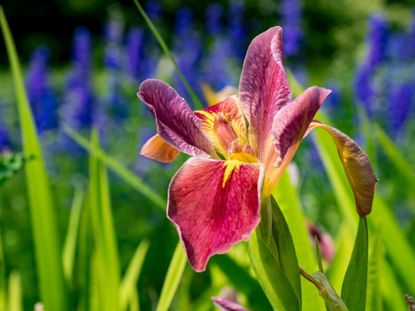Growing Japanese Iris Plants - Information And Care Of Japanese Iris


When you are looking for an easy-care flower that loves wet conditions, then the Japanese iris (Iris ensata) is just what the doctor ordered. This flowering perennial is available in a range of colors, including purples, blues, and whites, with attractive medium green foliage. Care of Japanese iris is moderately simple when the plant is located properly. Learning when to plant Japanese irises is also an important part of their performance.
Growing Japanese Iris Plants
The timetable for when to plant Japanese irises may involve amending the soil with acidic, organic amendments prior to planting the rhizomes in early fall. Unlike many garden flowers, Japanese iris care does not involve planting in a well-draining soil. In fact, growing Japanese iris plants flourish in boggy areas, near ponds and water features or even potted and placed in these bodies of water. Water should be acidic. If you're unsure of the pH of your water, add 2 to 3 teaspoons (10-15 ml.) of vinegar to a gallon of water to obtain the level needed for successful care of Japanese iris. If a pond or water feature is not available, growing Japanese iris plants is best done in an area that remains damp and moist for best performance and easiest care of Japanese iris.
Care of Japanese Iris
Once planted and placed in the pond, Japanese iris care is minimal. Limit fertilization to plants with a well-developed root system, and only use plant food that is high in nitrogen. Japanese iris care will include the division of the rhizomes every three to four years. Crowded plants tend to offer fewer blooms. Division keeps growing Japanese iris plants in optimum condition to provide the best possible bloom in summer. After division, consider placing a few rhizomes in pots to live in your water feature or pond. Pot in a heavy soil, such as red clay mixed with sand. Growing Japanese iris plants are rarely bothered by disease or the borer which often attacks the traditional bearded iris. You can enjoy growing Japanese iris plants with delicate blooms in moist and shady locations if you provide plenty of acidic water. This simplifies their care and lets you just enjoy the flowers.
Gardening tips, videos, info and more delivered right to your inbox!
Sign up for the Gardening Know How newsletter today and receive a free download of our most popular eBook "How to Grow Delicious Tomatoes."

Becca Badgett was a regular contributor to Gardening Know How for ten years. Co-author of the book How to Grow an EMERGENCY Garden, Becca specializes in succulent and cactus gardening.
-
 Urban Beekeeping Guide: Top Tips For Raising Bees In The City
Urban Beekeeping Guide: Top Tips For Raising Bees In The CityUrban beekeeping can be a rewarding and appreciated pastime, but first be sure it’s legal in your city and learn the ropes of beekeeping.
By Mary Ellen Ellis
-
 2024 Plant Of The Year: Why Experts Say Philodendron Is The “It” Plant Of The Year
2024 Plant Of The Year: Why Experts Say Philodendron Is The “It” Plant Of The YearWe aren’t surprised that philodendron was designated the plant of the year. Versatile, easy-care and lovely, it’s the houseplant of the year 2024!
By Bonnie L. Grant